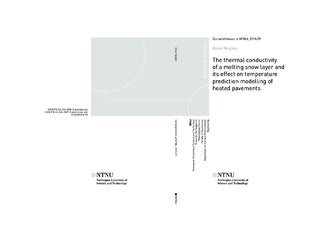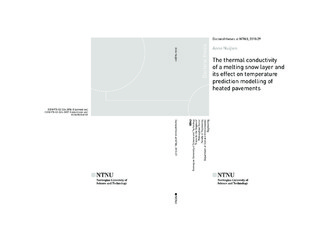| dc.contributor.advisor | Hoff, Inge | |
| dc.contributor.advisor | Høyland, Knut Vilhelm | |
| dc.contributor.advisor | Scarpas, Tom | |
| dc.contributor.author | Nuijten, Anne | |
| dc.date.accessioned | 2018-02-15T09:54:31Z | |
| dc.date.available | 2018-02-15T09:54:31Z | |
| dc.date.issued | 2018 | |
| dc.identifier.isbn | 978-82-326-2857-5 | |
| dc.identifier.issn | 1503-8181 | |
| dc.identifier.uri | http://hdl.handle.net/11250/2484951 | |
| dc.description.abstract | During winter time snow and frost formation on roads can cause slippery conditions leading to reduced safety and decreased mobility. To prevent slippery conditions winter maintenance measures are taken such as snow ploughing, sanding or applying de-icing agents. Heating of pavements can be an effective way of snow and ice removal but often have high operational costs. Since heated pavements are nowadays used more often as part of the winter maintenance in Scandinavian countries it becomes more important to be able to get a better understanding in how these systems work and how external factors influence the heat balance in order to reduce the energy needs. A challenging aspect about modelling the energy balance of a with snow covered heated pavement is that the snow layer itself largely affects the energy balance at the surface and that the snow properties are not constant. During the melting process these properties vary greatly. The main objective is of this study is therefore to determine the thermal conductivity of a melting snow layer and its effect on temperature and surface condition modelling of heated pavements.
Laboratory experiments on the melting process of uncompressed and compressed snow on heated pavements were performed to gain a better understanding of the snow melting processes on heated pavements and the change of the properties of the snow layer during the melting process. It was found that less energy is needed to melt uncompressed snow on a heated pavement than compressed snow when the snow layers are not further physically compacted during the melting process. Compression largely affects the snow melting process due to changes in the snow structure and snow properties; it increases the density and thereby also the thermal conductivity. This should give a more efficient heat transfer and a shorter melting time but this was not found to be the case. The compression and increased density has two other vital consequences; a) Higher density gives a lower permeability and higher capillary forces and b) stronger snow. The higher capillary forces give the snow better capability to absorb melt-water so that air gaps can form between the asphalt surface and the snow layer. Air gaps on the asphalt plate would decrease the conductivity significantly in a thin bottom-layer of the snow and reduce the heat transfer coefficient between the asphalt plate and the snow. The stronger snow would contribute to maintaining such air pockets or layers as stronger snow can support a larger span under gravity actions.
Freshly fallen snow has a fairly low thermal conductivity and acts as a good insulator. The thermal properties can however vary greatly during the melting process. The effective thermal conductivity is often described as a function of the density. Most relationships are based on data retrieved from thermal conductivity measurements of various types of seasonal snow with densities up to 600 kg m-3 where the snow density often increases due to settling and to a lesser extent due to an increase in water content. With increasing density those formulas approach the value for ice instead of water. The effective thermal conductivity can be modelled based on the volume fractions and the thermal conductivities of ice, water and air. The bulk thermal conductivity of the snow was modelled in three simple models. The first model had the three materials in series, the second in parallel and the third was a combined parallel and series system in which ice and air are modelled as a series system and water and ice/air are modelled in parallel. The results were compared with existing models for dry and moist snow. Only the combined series/parallel fitted both the earlier (dry snow) models and resulted in the value for the conductivity of water when all snow was melted. Comparing the three bulk approaches the effective thermal conductivity of a melting snow layer on a heated pavement can be best described as a combination of a parallel and series system.
A temperature and surface condition prediction model was developed and validated for a case study for Oslo Airport, Norway. In combination with weather forecasts it can be used by airports to predict slippery conditions a few hours ahead of time. The presented model is stable and can accurately predict the surface temperature during most of the winter season. When run in “now-casting” mode (3 hours ahead of time) the average error of the model (predicted surface temperature minus the measured surface temperature) is 0.25 °C and the RMSE is 1.65 °C. The thermal resistance through the snow or ice layer is neglected for this case study, since at Oslo Airport only a very thin snow layer is accepted before snow removal is initiated.
A new heated pavement system was installed in the municipality Bærum in Norway and equipped with temperature sensors and a weather station. Data was collected during the winter season 2015-2016 and used as input for the temperature prediction model for heated pavements. The model is based on the runway surface temperature prediction model and includes the thermal conductivity through the snow when snow is present at the surface. The above described effective thermal conductivity model was compared to a model in which the thermal conductivity was related to the density. Results show that when the liquid water content of the snow is very small the thermal conductivity through the snow layer can best be determined based on the formula in which the thermal conductivity is a function of the density. For a liquid water content above zero (when the snow starts to melt) the thermal conductivity can best be determined based on the proposed thermal conductivity model. | nb_NO |
| dc.language.iso | eng | nb_NO |
| dc.publisher | NTNU | nb_NO |
| dc.relation.ispartofseries | Doctoral theses at NTNU;2018:29 | |
| dc.relation.haspart | Paper 1:
Nuijten, Anne.
Runway temperature prediction, a case study for Oslo Airport, Norway. Cold Regions Science and Technology 2016 ;Volum 125. s. 72-84
https://doi.org/10.1016/j.coldregions.2016.02.004 | |
| dc.relation.haspart | Paper 2:
Nuijten, Anne; Høyland, Knut Vilhelm.
Comparison of melting processes of dry uncompressed and compressed snow on heated pavements. Cold Regions Science and Technology 2016 ;Volum 129. s. 69-76
https://doi.org/10.1016/j.coldregions.2016.06.010 | |
| dc.relation.haspart | Paper 3:
Nuijten, Anne; Høyland, Knut Vilhelm.
Modelling the thermal conductivity of a melting snow layer on a heated pavement. Cold Regions Science and Technology 2017 ;Volum 140. s. 20-29
https://doi.org/10.1016/j.coldregions.2017.04.008 | |
| dc.relation.haspart | Paper 4:
Nuijten, A.D.W., Hoff, I. and Høyland, K.V. Modelling surface temperatures for snow
covered roads, a case study for a heated pavement in Bærum, Norway.
- Is not included due to copyright. | |
| dc.title | The thermal conductivity of a melting snow layer and its effect on temperature and surface condition modelling of heated pavements | nb_NO |
| dc.type | Doctoral thesis | nb_NO |
| dc.subject.nsi | VDP::Teknologi: 500::Bygningsfag: 530 | nb_NO |
| dc.description.localcode | Digital full text not available | nb_NO |

